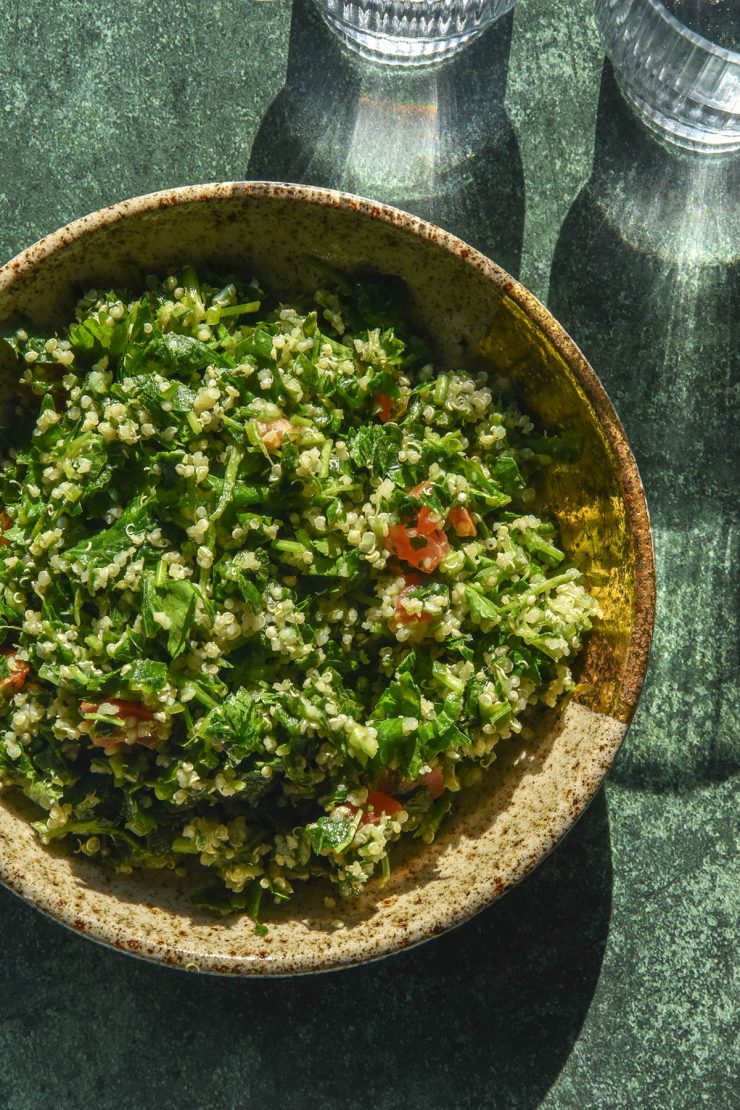
After developing some low FODMAP falafel recently, I wanted to build a group of recipes to serve with them (namely in low FODMAP falafel bowls). Of course, a low FODMAP tabbouleh was first on my agenda. This easy Lebanese inspired salad is fresh, light and packed with flavour. It is also gluten free, dairy free, vegan and low FODMAP.
Before we dive in, a quick note: my intention in developing these recipes is never to take from a cuisine outside my own. I aim to develop delicious recipes that people with dietary restrictions can safely eat, never to bastardise another cuisine.
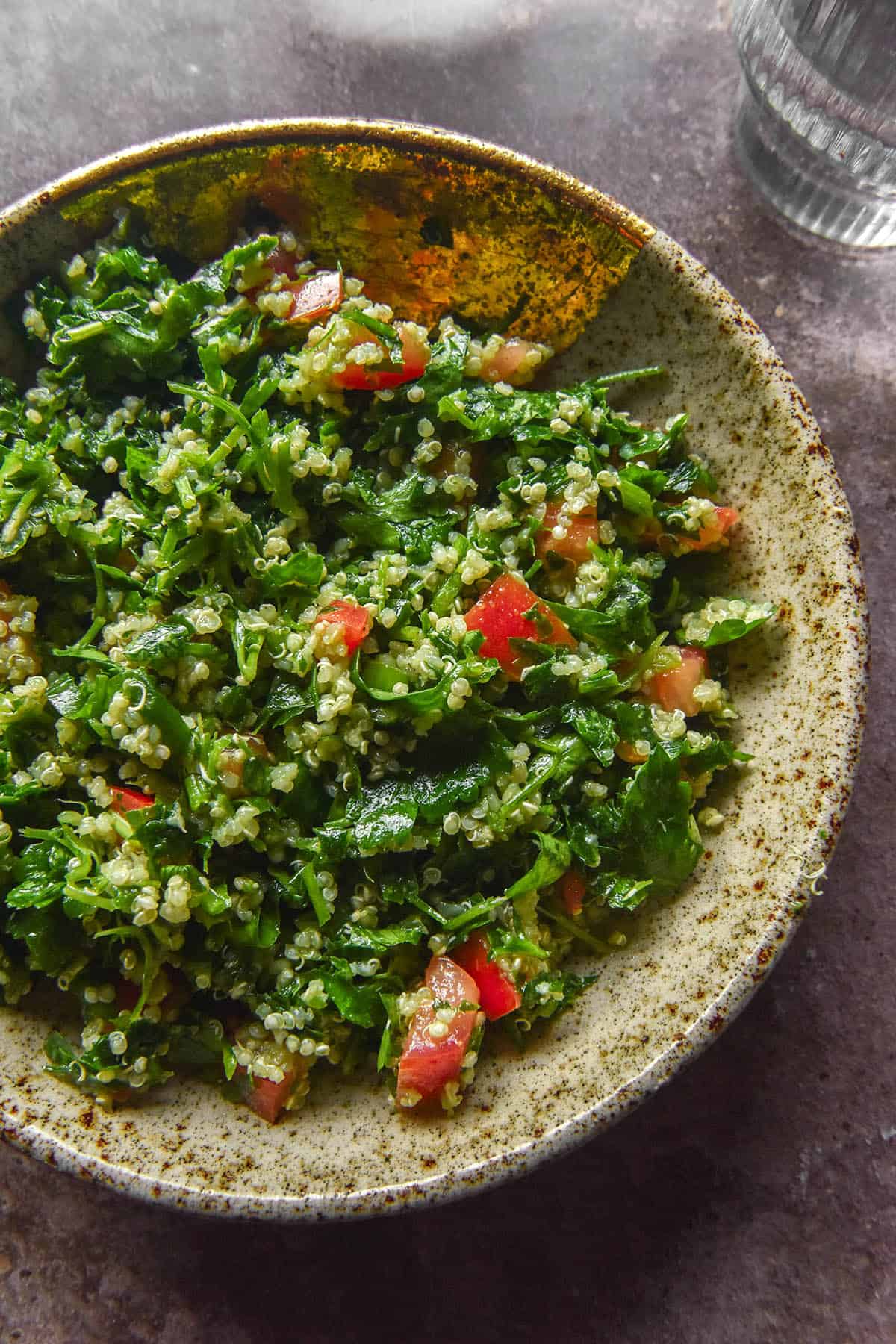
Low FODMAP tabbouleh (gluten free)
Traditionally, tabbouleh is a parsley heavy salad made with bulgur wheat, spring onions, tomatoes and a zingy lemon and olive oil dressing. Some iterations add mint and some seem to add garlic to the dressing.
To keep this salad gluten free, I have used quinoa in place of bulgur wheat. Bulgur wheat does have a low FODMAP threshold so it is an option if you don’t have issues with wheat (more in the FODMAP section).
Next, I have used only spring onion greens as opposed to the whites and greens. Finally, I have added a small (and optional) amount of pickled garlic and adjusted the tomato content. A few simple tweaks for a deliciously fresh and vibrant tabbouleh that is perfect in a low FODMAP falafel bowl.
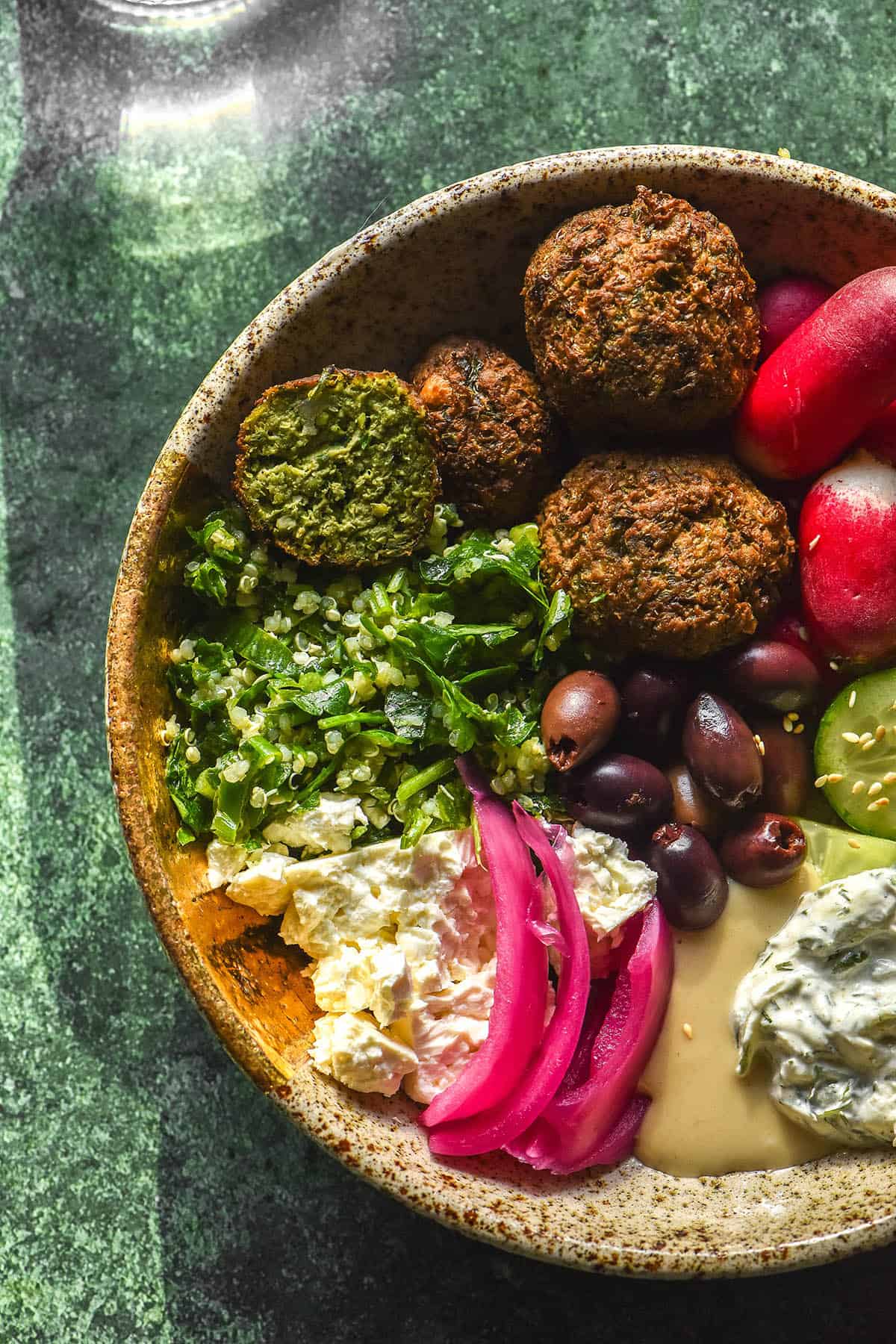
FODMAP notes
These FODMAP thresholds are current as of June 2025. I will periodically update the post to reflect the latest FODMAP information provided by Monash.
I have used white quinoa here as it matches the look of bulgur wheat in a traditional tabbouleh salad. White quinoa (along with black quinoa) is low FODMAP in up to 500g serves, which makes it an excellent low FDOMAP addition.
Bulgur wheat, which is traditionally used in tabbouleh, is low FODMAP in 44g serves. In 88g serves, it contains high amounts of GOS and fructans.
If you are fine with wheat and are not serving this tabbouleh alongside any other FODMAP foods, you can absolutely use bulgur wheat. I have no advice on how to prepare it because I myself don’t tolerate wheat, but you do you.
A wheat version might not be appropriate if you are making my low FODMAP falafel bowls. Edamame, the bean used to make the falafel, contain fructans as its primary FODMAP. You run the risk of FODMAP stacking by serving them together.
Monash does not list an upper quantity for parsley on their app or website. However, they don’t for any other perceived low FODMAP herb either. This leads me to assume that the low numbers on their app are based on ‘an average serving’ of a herb, rather than anything else. If this changes, I will update the post.
Pickled garlic (an optional ingredient) is low FODMAP in 3g serves or around 1 clove. It remains low FODMAP in serves of up to 29g, when it becomes moderate for fructose.
Finally, our old friend spring onion greens. Spring onion greens remain low FODMAP in serves of up to 97g per person.
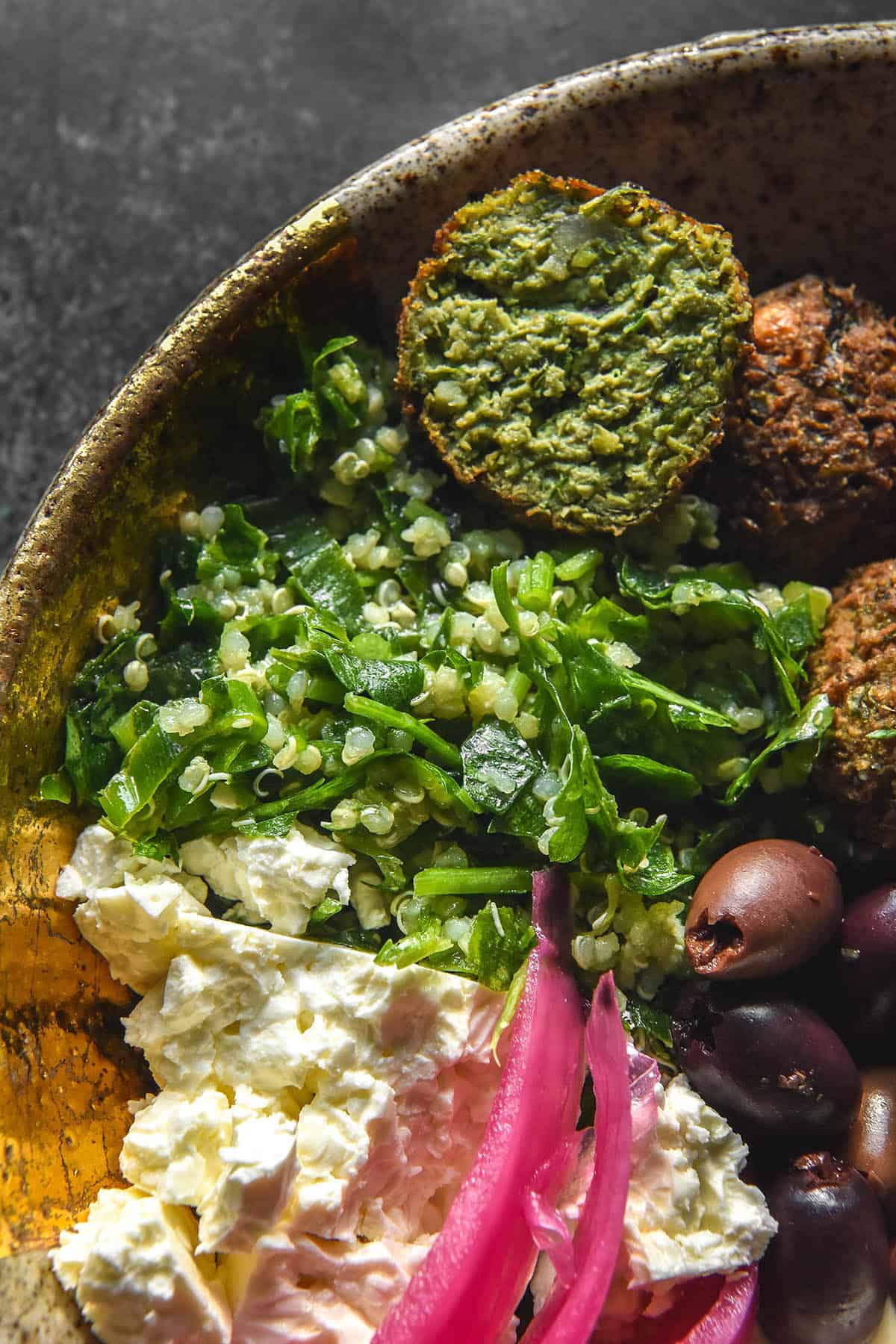
Notes on the tomato
Seasoned FODMAPpers will remember the collective despair when Monash significantly lowered the threshold for tomatoes. Although, of course, it’s all about your own tolerance after the elimination diet, it was still a blow to the collective psyche.
Common raw tomatoes, as of June 2025, are low FODMAP in 65g, which is approximately 1/2 a medium tomato. In 75g serves they contain moderate fructose.
Most tabbouleh recipes around the size of this recipe contain about 2-3 tomatoes. In our case, I think it’s best to determine what you intend to eat your tabbouleh with before deciding how many tomatoes to add.
For example: if you plan to eat it with cucumbers (whose FODMAP is fructose) consider adding a lesser quantity. If you intend to eat it with solely a protein, you can add a higher quantity.
Although not traditional, you can also consider omitting the tomato entirely. This will drastically lessen the fructose content (or eliminate it entirely if you omit the pickled garlic) which frees you up to eat the recipe with a higher fructose meal.
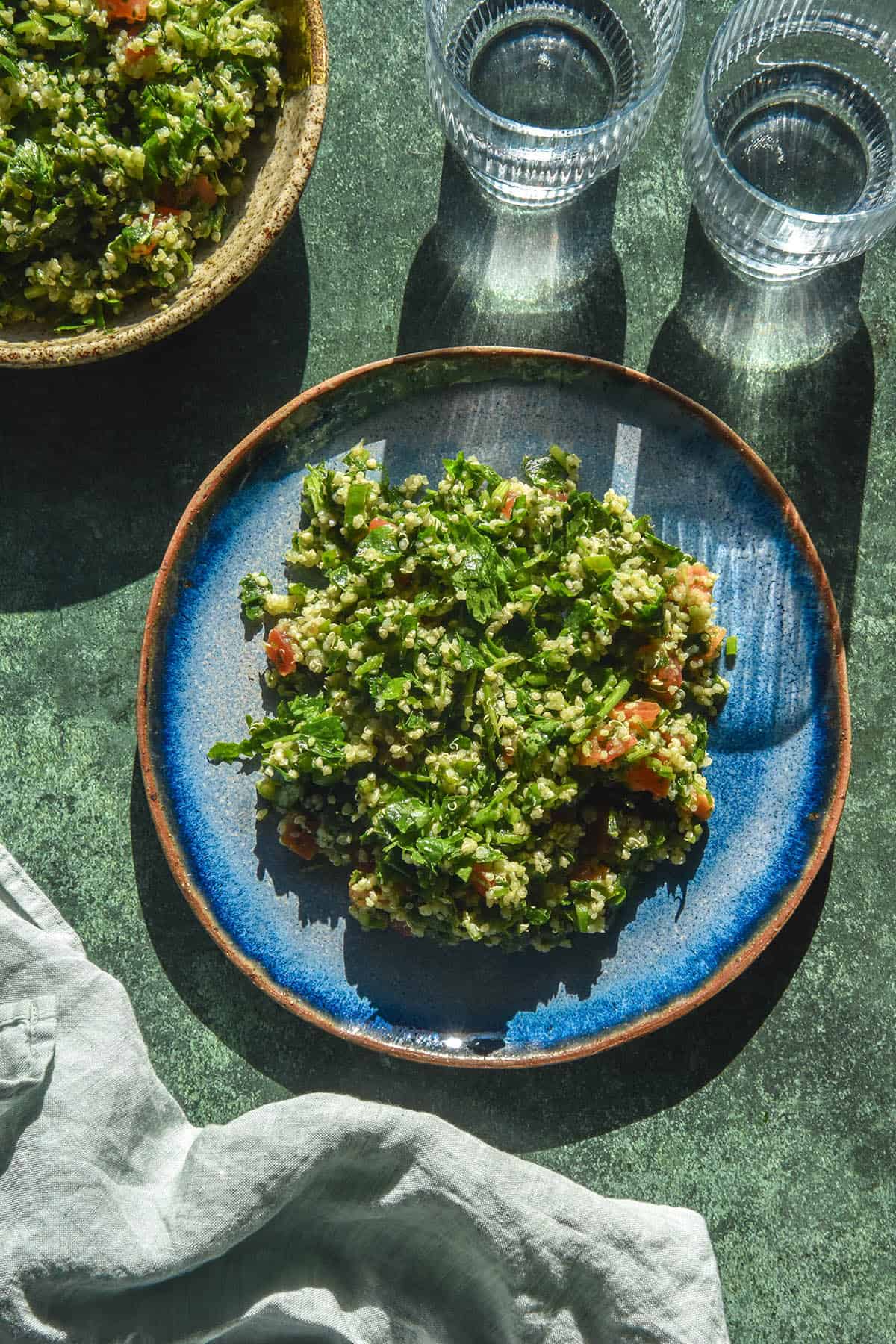
Recipe tips
- Tabbouleh is supposed to be all about the parsley with just a hint of quinoa peeking through. Some people also add a little bit of mint, which would be lovely.
- Try to use as little liquid as possible to cook your quinoa. You want it to be fluffy and cooked through without adding too much moisture to the the tabbouleh.
- On that note: make sure it is cooled and dried before using it to make the dish.
- Add the dressing to taste! This is your salad, after all. It should taste good to you. I prefer a higher ratio of lemon to oil, but taste and see what works for you.
- Gently draining the tomatoes is necessary to ensure your tabbouleh doesn’t become waterlogged. You can scoop out the innards and save them for a rainy day or simply place the chopped tomato and a little salt in a sieve over the sink.
- If common tomatoes are out of season, you can also use cherry tomatoes. Cherry tomatoes are low FODMAP in 45g serves per person (around 5 medium cherry tomatoes per serve).
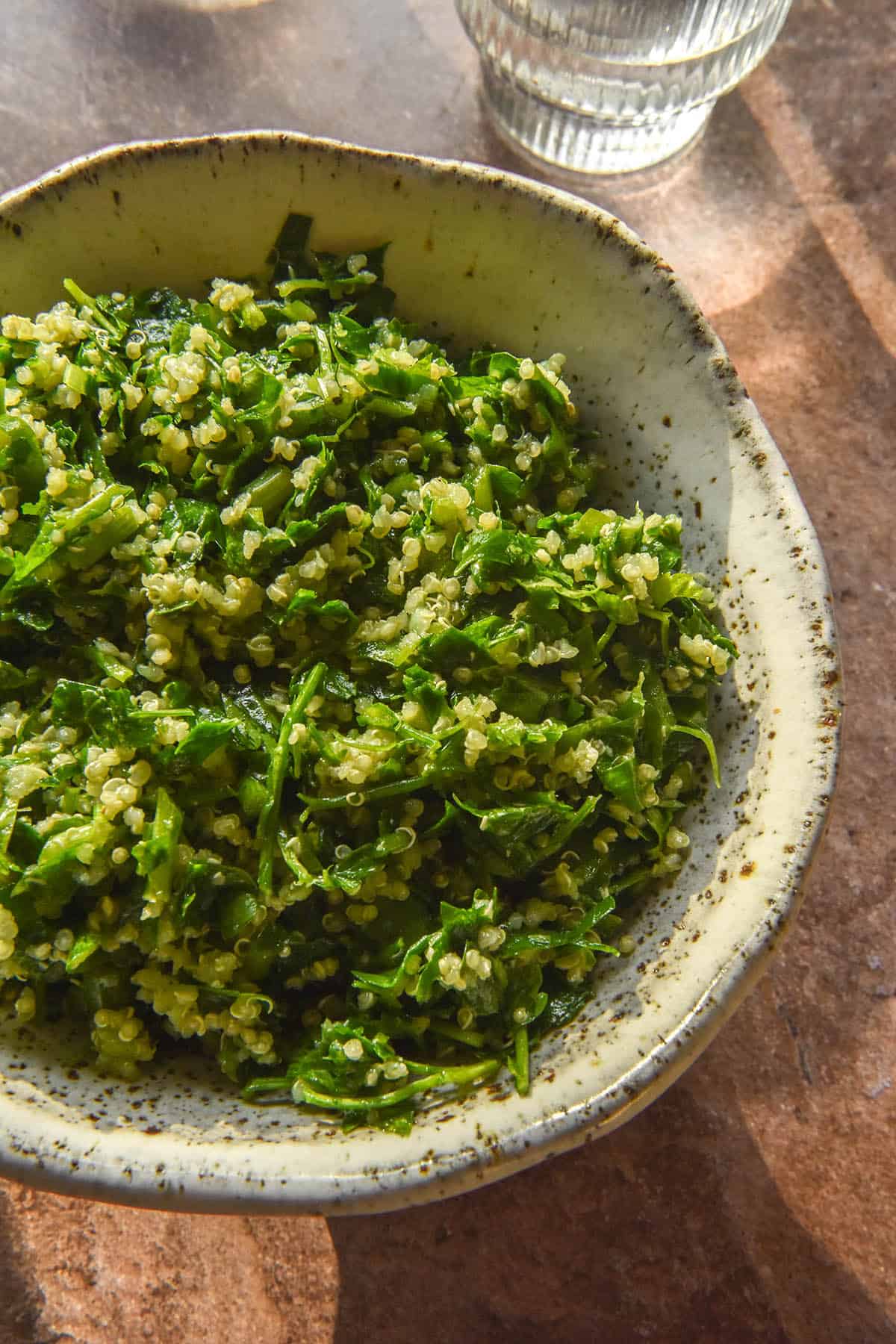
More low FODMAP salad recipes
- Low FODMAP Caesar salad (vegan option)
- Low FODMAP crispy rice salad (Nam Khao inspired)
- Roasted pumpkin and quinoa salad
- Radicchio and blue cheese salad with honey walnuts
- Roasted pumpkin feta salad
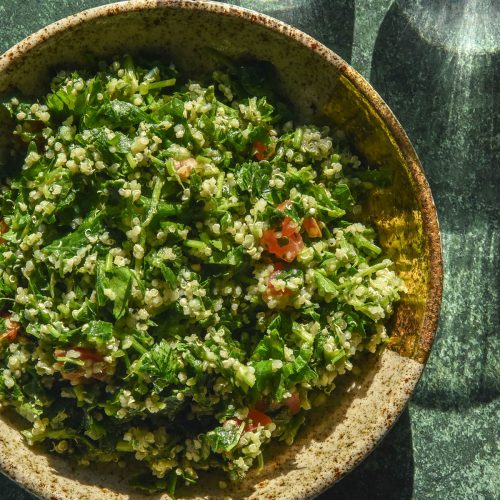
Low FODMAP tabbouleh
Ingredients
- 100g (1/2 cup)* white quinoa
- 250-310ml (1- 1 ½ cups)* water
- 1 medium common tomato chopped into small cubes (approx. 40g tomato per serve)
- Pinch of fine salt
- 200 g flat leaf parsley or a mix of both finely chopped (this was 2 extra large bunches from an independent grocer, I'd recommend weighing your bunches as the parsley is critical to a good tabbouleh)
- 5-6 spring onion greens finely chopped
- 60-100 ml (3-5 tablespoons)* fresh lemon juice, to your tastes
- 60-80 ml (3-4 tablespoons)* good quality olive oil, to your tastes
- Seasoning to your tastes
- 1-2 cloves pickled garlic, crushed (optional, see notes)
Instructions
- Rinse the quinoa and place it in a medium saucepan with 250ml water. Place over a medium heat, add a pinch of salt and cook until the water has evaporated and the quinoa grains have unfurled. If your quinoa doesn't look fully cooked by the time the water has evaporate, add the additional 60ml to finish cooking. Remove from the heat, then cover the saucepan and allow to steam dry for 15-20 minutes. Allow the quinoa to cool completely before proceeding.
- Chop your tomato into small cubes and place it in a sieve over a bowl or the sink. Sprinkle over a pinch of salt to encourage the tomato to expel excess liquid.
- Finely chop the parsley and spring onion greens and add them to a large bowl. I find it easier to knuckle down and chop them myself as opposed to using a food processor. My experience was that the processor made for soggy and unevenly cut parsley with long stringy stems.
- Add the cool quinoa to the bowl and stir to combine.
- Add the olive oil and lemon juice in increments until you reach your desired level of flavour. You might need more or less than I specified – it’s a matter of preference (but lemony zing is important!
- Season to taste and stir through the pickled garlic, if you’re using it. Taste and adjust as necessary, then stir through the tomato. I find it best to do this last to avoid making it too mushy. Serve with whatever you fancy! Leftovers keep well in an airtight container in the fridge for 2-4 days. I recommend adding the tomato fresh if you plan to make this dish ahead of time.
Notes
- See the body of the post for FODMAP notes.
- Pickled garlic is a new low FODMAP ingredient. It is low FODMAP in 3g serves and contains moderate amounts of fructose in serves exceeding 29g. I have a recipe for pickled garlic here.
- Loads of parsley is integral to a good tabbouleh. I trim the very bottom of the stems and then use the stems (finely chopped) in the tabbouleh as well. If you’re based in Australia, I recommend trying to get your parsley somewhere other than the big supermarkets as they are notoriously stingy with herbs. Buying 200g of parsley will become quite expensive when you are buying those (criminal) 15g plastic packets. Parsley is easily purchased from independent grocers and the bunches are enormous; it shouldn’t be expensive.
- Scale the tomato up or down depending on what you are serving your tabbouleh with. 65g of common tomato is a low FODMAP (fructose) serve and 75g contains moderate amounts of fructose.
- If you are serving your tabbouleh with a higher fructose ingredient, scale down the tomato or omit it altogether.

No Comments